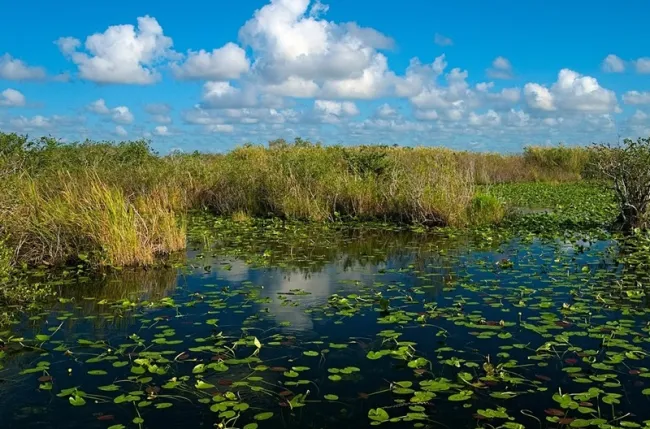
Everglades National Park, located in southern Florida, is the largest subtropical wilderness in the United States. Covering more than 1.5 million acres, the park is a UNESCO World Heritage Site, a Wetland of International Importance, and a designated International Biosphere Reserve. The park preserves an unparalleled landscape of slow-moving waters, marshes, sawgrass prairies, and mangrove forests. Known for its incredible biodiversity, the Everglades is home to numerous endangered species, including the Florida panther, American crocodile, and West Indian manatee.
History of the Park
The idea of preserving the Everglades began in the early 20th century when conservationists recognized the importance of this unique ecosystem. In 1934, Congress authorized the creation of Everglades National Park, though it took years of effort to acquire the necessary land. The park was officially established in 1947, making it the first national park created to protect a fragile ecosystem rather than a scenic landscape. Over the years, efforts to restore and protect the Everglades have continued, with the Comprehensive Everglades Restoration Plan (CERP) being one of the most significant environmental restoration efforts in the world.
Main Features
The Everglades is a mosaic of diverse ecosystems, each with its unique features:
- Sawgrass Marshes: These are the iconic features of the park, with vast stretches of sawgrass that dominate the landscape.
- Mangrove Forests: Found along the coastal areas, these forests provide crucial breeding grounds for fish and other wildlife.
- Cypress Swamps: These tree-filled wetlands create a mysterious and serene atmosphere.
- Marine Ecosystems: The park's waters are rich with coral reefs, seagrass beds, and marine wildlife.
- Wildlife: The Everglades is home to a variety of animals, including alligators, crocodiles, manatees, and more than 360 species of birds.
Types of Trails
Everglades National Park offers a range of trails, catering to different levels of hikers:
- Anhinga Trail: A 0.8-mile paved trail that is one of the most popular in the park, offering excellent opportunities to view wildlife, especially alligators and wading birds.
- Gumbo Limbo Trail: A 0.4-mile paved loop through a hardwood hammock, providing a shaded walk through lush tropical vegetation.
- Pa-hay-okee Trail: A short boardwalk trail that offers expansive views of the sawgrass prairie.
- Shark Valley Trail: A 15-mile loop trail that can be explored by foot, bike, or tram, offering a close-up view of the wildlife-rich habitats.
- Pineland Trails: These longer trails take visitors through the park's pinelands and offer a more remote experience.
Crowd Expectations and Annual Visitors
Everglades National Park receives over one million visitors annually. Peak season is during the winter months, from December to April, when the weather is cooler and drier. During this time, trails, visitor centers, and popular sites like Shark Valley can get crowded. Summer months see fewer visitors, but the weather is hot and humid, and there are more mosquitoes.
Accessibility for Seniors
Everglades National Park is designed to be accessible for visitors of all ages. Many of the park's main attractions, such as the Anhinga Trail, Gumbo Limbo Trail, and Pa-hay-okee Overlook, are either paved or feature boardwalks, making them senior-friendly. Tram tours at Shark Valley are also an excellent option for seniors to explore the park without extensive walking.
Accessibility for Wheelchairs
The park offers several wheelchair-accessible facilities and trails, including the Anhinga Trail, Gumbo Limbo Trail, and some sections of the Shark Valley area. Visitor centers have accessible restrooms and parking, and the tram tour at Shark Valley is also wheelchair accessible.
Park Amenities
Everglades National Park is equipped with various amenities to make visitors’ experiences enjoyable:
- Visitor Centers: There are three main visitor centers—Ernest F. Coe, Shark Valley, and Gulf Coast—offering exhibits, information, and educational programs.
- Restrooms and Picnic Areas: These are available at key locations throughout the park.
- Boat Tours: Several companies offer boat tours of the park’s waterways, providing a unique perspective of the park’s ecosystems.
- Guided Tours and Ranger Programs: These educational programs are available seasonally and offer insight into the park's natural and cultural history.
Camping Facilities
The park has several camping options:
- Frontcountry Camping: There are two frontcountry campgrounds—Flamingo and Long Pine Key. Both are accessible by car and offer sites for tents and RVs.
- Backcountry Camping: The park offers wilderness camping for those looking for a more remote experience. Backcountry sites are accessible by canoe, kayak, or hiking and require a permit.
Access to Lodging
While there are no hotels within the park, lodging can be found in nearby communities such as Homestead, Florida City, and Everglades City. Additionally, the Flamingo area offers eco-tents and houseboat rentals for a unique overnight experience within the park.
Pet-Friendliness
Pets are allowed in some areas of the park, including campgrounds and along roads, but they are not permitted on most trails, boardwalks, or in the backcountry. Visitors should check specific pet policies before bringing their pets and ensure they follow all regulations to protect the wildlife and natural environment.
Best Months to Visit
The best time to visit Everglades National Park is during the dry season, from December to April. During these months, temperatures are cooler, humidity is lower, and mosquitoes are less of an issue. Wildlife is also more visible, as animals congregate around the remaining water sources. The wet season, from May to November, is hot, humid, and buggy, but offers lush, green landscapes and fewer crowds.
Conclusion
Everglades National Park is a treasure trove of biodiversity and natural beauty. Whether you're exploring the tranquil waters by boat, hiking through unique ecosystems, or spotting wildlife along a boardwalk trail, the park offers a memorable experience for visitors of all ages and abilities. With its year-round opportunities for adventure, the Everglades stands as one of America's most important and captivating natural wonders.



